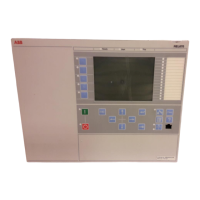Where:
RLi
The positive sequence resistance of i
th
section (Function setting)
RLj
The positive sequence of resistance of faulted section (function setting)
XLi
The positive sequence reactance of i
th
section (Function setting)
XLj
The positive sequence of reactance of faulted section (function setting)
REOverRLi
The positive sequence resistance of i
th
section
REOverRLj
The positive sequence of resistance of faulted section (function setting)
XEOverXLi
The positive sequence reactance of i
th
section (Function setting)
XEOverXLj
The positive sequence of reactance of faulted section (function setting)
p
Fault position in per unit of the respective section line length
Fault section
The section in which the fault exists
3. Wait for 0.09 seconds and update the voltage and current back to the values
provided in table 26.
4. Wait for a few seconds, and check the distance-to-fault value in km displayed
on the local HMI. This implies with:
jLineLengthpiLineLengthFLTDIST
tionfault
i
1sec
1
IECEQUATION15120 V1 EN-US (Equation 24)
Where:
Linelengthi
Line length in Km of the i
th
section
Linelengthj
Line length in Km of the faulted section
p
Fault position in per unit of the respective section
Verifying the case
SystemType
=
ATCatenary
GUID-62ADD159-6EF8-4FD7-88D0-D71F4FC40A4A v1
1. Apply the voltage and current as shown in Table 28:
Table 28: Pre-fault voltages and current
Signal
Magnitude (Volts) Angle (Degrees)
IECEQUATION15084 V1 EN-US
55 0
IECEQUATION15085 V1 EN-US
55 180
IECEQUATION15086 V1 EN-US
0 0
IECEQUATION15087 V1 EN-US
0 180
2. Wait for a few seconds and apply voltage and current according to Table 29
depending on which fault loop is to be verified.
1MRK 506 377-UEN C Section 10
Testing functionality by secondary injection
Railway application RER670 2.2 IEC 173
Commissioning manual

